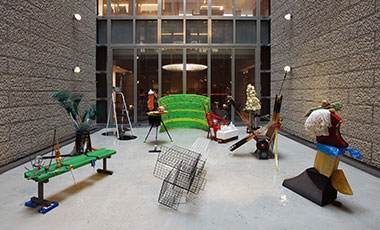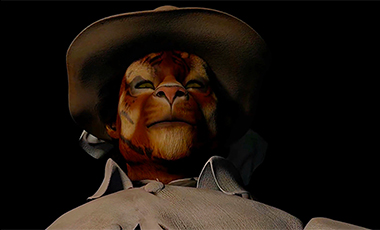
According to the curatorial statement for 《Five Artists: Sites Encountered》, M+’s latest exhibition, the notion of site provides a gateway to thinking about individual and cultural identities, sense of rootedness, and our built environment. These are essential topics, particularly at a time of rising nationalist fervour and forced displacement.
Text Christie Lee
Images Courtesy of M+, Hong Kong
But arguably more so when it opened two days before a million Hongkongers took to the streets in protest of the anti-extradition bill on 9 June.
In the past two months, the anti-extradition protests have opened up dialogues not only about freedom and democracy but also the relationship we have with the community, with the various ‘sites’ we inhabit as residents, as employees, as activists—and especially so when the movement has extended outward from the city’s financial district. Against this very context, or ‘site’, the art on display at 《Five Artists: Sites Encountered》 appear to take on an urgency, offering a funnel through which one can contemplate about the past, present and future of Hong Kong.
Charlotte Posenenske’s 〈Series D〉 and 〈DW Vierkantrohre〉 appear like air ducts but are actually steel and corrugated cardboard sculptures that can be assembled and reassembled according to the space. Posenenske wasn’t as interested in individual expression—as many artists were during the 1960s—as she was in creating a visual language that appears stripped of embellishment, but can be calibrated at will by anyone with it. Her art, based on egalitarianism principles, is as much artistic as sociological experimentation. Whether she succeeded or not is debatable—the artist ‘quit’ the art world in 1968 when she thought art could not bridge inequality gaps in society.

Installation view of 《Five Artists: Sites Encountered》 at the M+ Pavilion, 2019. ⓒM+, Hong Kong.
The gap between utopia and reality is also manifested in Lee Bul’s works. A vitrine comprising an array of maquettes by the Korean artist sits at the centre of the gallery space. These maquettes were inspired by Russian architect Vladirmir Tatlin, whose Tatlin Tower remains a painful reminder of the ultimate failure of the Constructivists’ utopian dream. Lee Bul’s maquettes similarly feature angular shapes and reflective surfaces, but by placing them in a vitrine, evocative perhaps, of museum artefacts, these visions of utopia appear to remain forever ‘locked up’. These maquettes acted as blueprints for some of the artist’s large-scale sculptures, including 〈Untitled Sculpture W6-2〉, which consists of a chaotic jumble of sheet metal, steel rods and mirrored panels. Despite the meticulous construction that went into it, the convoluted structure points to the impossibility of these utopian dreams.

Installation view of 《Five Artists: Sites Encountered》 at the M+ Pavilion, 2019. ⓒM+, Hong Kong.
While Posenenske strips her work of individual expression, May Fung’s 〈She Said Why Me〉 explores the search for identity from a subjective point of view. The eight-minute film features a blind-folded woman ‘feeling’—quite literally—her way through Hong Kong’s streets, temples and iconic landmarks. This is interspersed with childhood photos and black and white archival clips of old Hong Kong. Filmed in 1989, five years after the Sino-British Joint Declaration was signed, the work mirrored many Hongkongers’ own search for their identity, and so in a way, bridging the personal and the collective. The fragmentary collage also reinforces the idea that the relationship with the city can be constructed and reconstructed again and again.

Installation view of 《Five Artists: Sites Encountered》 at the M+ Pavilion, 2019. ⓒM+, Hong Kong.
Of the works on display, Ana Mendieta’s series of seven video art pieces is most direct in teasing out the relationship between our body and site. In 〈Silueta del Laberinto〉 (Labyrinth Blood Imprint), a camera moves through architectural ruins in Yagul, Mexico before settling on a blood-stained body silhouette on the ground. In 〈Alma, Silueta en Fuego〉 (Soul, Silhouette on Fire), the outline of a body is filled with ‘white material’ before it is set on fire, leaving a residue of ashes on the ground. Meanwhile, 〈Untitled: Silueta Series〉 puts the idea of the ephemeral body on full display—an outline of a body is formed on the ground using gunpowder, the figure slowly burns, leaving behind a scorched outline. The body has been uprooted from the site, but its phantom remains, unwilling to dissipate. The idea of exile followed the artist from childhood till death. Born in Cuba, Mendieta was exiled from her homeland and placed in an Iowa orphanage at the age of 12. In 1985, some 26 years later, she mysteriously fell to her death from her 34th floor apartment in Manhattan.

Installation view of 《Five Artists: Sites Encountered》 at the M+ Pavilion, 2019. ⓒM+, Hong Kong.
The idea of ephemerality continues in the elevated outdoor terrace, where Lara Almarcegui’s 〈Construction Materials, M+, Hong Kong〉 provides a breakdown of the materials involved in the construction of the M+ building, pointing to the gap in time between when the gravel, sand and cement are mere rubble and when they become part of a bigger construction. This emphasis on the openness of materials brings one back, perhaps, to present-day Hong Kong, when protestors are dismantling the built environment—pedestrian barriers, traffic signs, what have you—before re-appropriating them into tools of civil disobedience. With the M+ building looming in the near distance, Almarcegui’s list asks what the city’s first contemporary art museum means as a site for representation in a city that is eternally negotiating its identity, and its place in the world.

Installation view of 《Five Artists: Sites Encountered》 at the M+ Pavilion, 2019. ⓒM+, Hong Kong.
Five Artists: Sites Encountered
June 7 – October 20, 2019
M+ Pavilion, Art Park, West Kowloon Cultural District
※ Click to Read the Full Article: https://www.cobosocial.com/dossiers/five-artists-sites-encountered/
※ This article was originally published in CoBo Social(https://www.cobosocial.com) on 22 AUG 2019 and reposted under authority of a partnership between KAMS and CoBo Social.
Christie Lee
Christie Lee is an arts journalist. Her articles have been published in Frieze, Artsy Editorial, Yishu, Randian, Artomity and The Peak magazine. A graduate of McGill University, she lives in London and Hong Kong.


